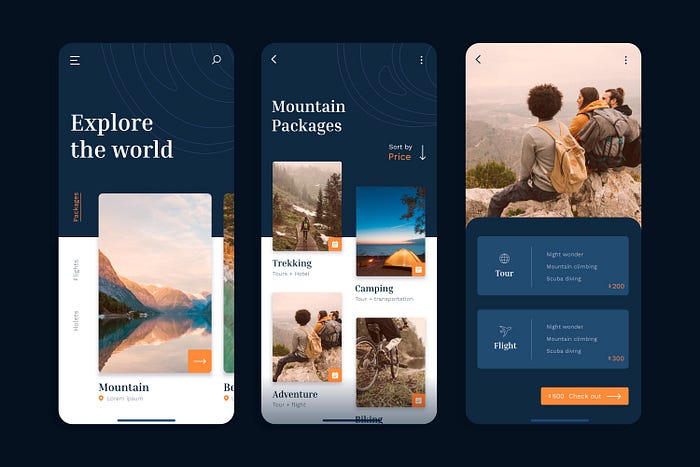
Design roles are becoming more specialized than ever. Two of the most talked-about roles in the design industry are Mobile App Designers and Product Designers. While both focus on creating beautiful and functional digital experiences, their goals, scope, and responsibilities are quite different.
If you’re considering a career in design—or trying to understand which role your project needs—this guide will help you clearly see the key differences between a Mobile App Designer and a Product Designer.
1. The Core Focus
Mobile App Designer:
A mobile app designer focuses primarily on mobile user interfaces and experiences. Their goal is to create visually engaging, easy-to-navigate, and responsive mobile screens that enhance usability on smaller devices.
They deal with details such as:
- Touch gestures and interactions
- Mobile navigation patterns
- Platform guidelines (iOS Human Interface Guidelines, Material Design)
- Optimizing layouts for different screen sizes
Product Designer:
A product designer, on the other hand, looks at the entire product experience—from idea to implementation. Their role includes defining how the product works, feels, and fits into users’ lives.
They balance design aesthetics with business strategy, user research, and long-term scalability.
2. Scope of Work
Mobile App Designer:
- Designs mobile-specific UIs (iOS, Android)
- Works closely with developers to ensure design feasibility
- Focuses on visual design, micro-interactions, and animations
- Ensures consistent design patterns across mobile screens
Product Designer:
- Oversees the full product lifecycle—from research and prototyping to testing and iteration
- Collaborates with stakeholders, developers, and marketers
- Defines product strategy and user journey
- Works on both mobile and web interfaces
In short, mobile app designers work on specific features or interfaces, while product designers guide the entire product vision.
3. Skills and Tools
Mobile App Designer Skills:
- UI/UX design fundamentals
- Prototyping and wireframing (Figma, Adobe XD, Sketch)
- Knowledge of platform-specific design systems
- Strong visual design and typography skills
Product Designer Skills:
- UX research and strategy
- Design thinking and problem-solving
- Cross-platform design (web + mobile)
- Prototyping, testing, and iteration
- Collaboration with product managers and developers
Product designers often use the same design tools as mobile app designers but combine them with research tools like Maze, UserTesting, or Hotjar to validate user behavior.
4. Goals and KPIs
Mobile App Designer Goals:
- Create a visually appealing and smooth mobile experience
- Increase app engagement and retention
- Optimize for performance and responsiveness
Product Designer Goals:
- Align design solutions with business goals
- Ensure end-to-end user satisfaction
- Drive growth through improved usability and functionality
In essence, while mobile app designers focus on how users interact with the app, product designers focus on why the product exists and how it evolves.
5. Collaboration
Mobile App Designer:
Typically works within a product or design team and collaborates closely with developers and UX researchers. Their main goal is to translate design concepts into pixel-perfect mobile experiences.
Product Designer:
Collaborates with product managers, engineers, marketers, and stakeholders. They are often involved in decision-making, influencing not just the design but also the direction of the product.
6. Career Path and Growth
A Mobile App Designer may grow into roles such as:
- Senior UI/UX Designer
- Mobile Design Lead
- Motion or Interaction Designer
A Product Designer can evolve into:
- Design Lead or Head of Product Design
- UX Strategist
- Product Manager
While both paths are rewarding, product design tends to have a broader business impact and more strategic involvement.
7. Real-World Example
Consider a food delivery app:
- A Mobile App Designer focuses on designing intuitive order screens, smooth checkout flows, and visually pleasing interfaces.
- A Product Designer defines the entire user journey—from searching for food to post-delivery feedback—and ensures that the design aligns with user needs and business goals.
8. Which One Should You Choose?
If you’re passionate about interface design, colors, and user interactions, start as a Mobile App Designer.
If you enjoy problem-solving, user research, and big-picture thinking, pursue Product Design.
Both roles are crucial to delivering seamless user experiences—but the scope and mindset differ.
The Role of Mobile App Designers
Mobile app designers are responsible for the user interface (UI) and user experience (UX) aspects of an app. Their goal is to make sure that users can easily navigate the app, perform tasks seamlessly, and enjoy their interaction with the product.
Their work bridges the gap between technology and human behavior. By understanding user needs, business goals, and technical constraints, they create designs that meet both user expectations and organizational objectives.
How Designers Turn Ideas Into Interactive Experiences
1. Understanding the Idea and Defining the Problem
Every successful app starts with an idea, but ideas need structure, purpose, and user relevance.
Mobile app designers begin by asking:
- Who are the users?
- What problem does the app solve?
- What are the business goals behind it?
Through workshops, brainstorming sessions, and stakeholder interviews, designers define the core features and functionalities needed to meet user needs.
2. Conducting User Research
Once the problem is defined, designers conduct user research to understand the target audience. This includes surveys, interviews, and analytics to learn how users behave, what they struggle with, and what they expect from the app.
User personas are then created to represent typical users, helping designers tailor experiences that resonate with the audience.
For example, a fitness app aimed at beginners will prioritize easy navigation, simple tracking tools, and clear progress reports.
3. Wireframing and Structuring the Experience
With insights in hand, designers sketch wireframes—blueprints of the app’s structure.
These wireframes define:
- Navigation paths
- Placement of buttons and menus
- User flows from one screen to another
Wireframes are crucial in visualizing how users will move through the app. They help identify potential pain points before investing time in colors, graphics, or animations.
Conclusion
While the titles Mobile App Designer and Product Designer may sound similar, their impact on product development is quite distinct.
Mobile app designers focus on interface excellence, while product designers take ownership of the entire product journey—from concept to market success.
At Devoq Design, a leading UI/UX Design Agency, our expert designers blend the best of both worlds—creating visually stunning apps and strategic product designs that deliver real results. Whether you’re building your first app or scaling a digital product, our design team ensures users love every interaction.



